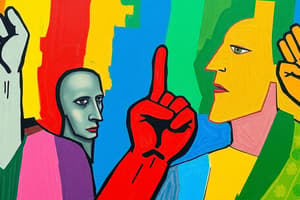Podcast
Questions and Answers
Which trait is emphasized to demonstrate the importance of family in Filipino culture?
Which trait is emphasized to demonstrate the importance of family in Filipino culture?
- Lack of Initiative
- Curiosity
- Sensitivity
- Respect for Elders (correct)
What does 'pakikisama' symbolize in Filipino culture?
What does 'pakikisama' symbolize in Filipino culture?
- Civic responsibility
- Individual achievement
- Camaraderie and good faith (correct)
- Disregard for others
How is Filipino culture characterized in terms of its adaptability?
How is Filipino culture characterized in terms of its adaptability?
- Rigid and unchanging
- Dynamic, flexible, and adaptive (correct)
- Stagnant
- Conservative and isolated
Which of the following is a common misconception associated with Filipino societal behavior?
Which of the following is a common misconception associated with Filipino societal behavior?
What aspect of Filipino culture is highlighted by their reaction to foreigners making generalizations?
What aspect of Filipino culture is highlighted by their reaction to foreigners making generalizations?
What characteristic is indicated by Filipinos' tendency to think regionally?
What characteristic is indicated by Filipinos' tendency to think regionally?
Which cultural value represents the belief in the importance of connections with others?
Which cultural value represents the belief in the importance of connections with others?
What is a likely motivation behind Filipino sensitivity towards criticism from outsiders?
What is a likely motivation behind Filipino sensitivity towards criticism from outsiders?
What is a characteristic of ethnocentrism?
What is a characteristic of ethnocentrism?
Which of the following is a method to mitigate ethnocentrism?
Which of the following is a method to mitigate ethnocentrism?
What does cultural relativism promote?
What does cultural relativism promote?
What best describes the term 'gender roles'?
What best describes the term 'gender roles'?
Which of the following represents xenocentrism?
Which of the following represents xenocentrism?
Which of the following is an example of primary innovation?
Which of the following is an example of primary innovation?
How does assimilation differ from acculturation?
How does assimilation differ from acculturation?
What harmful effect can arise from ethnocentrism in society?
What harmful effect can arise from ethnocentrism in society?
Which statement about cultural relativism is true?
Which statement about cultural relativism is true?
What does diffusion refer to in the context of social change?
What does diffusion refer to in the context of social change?
What should sacred traditions be treated as according to cultural relativism?
What should sacred traditions be treated as according to cultural relativism?
Which characteristic is NOT a common social difference among people?
Which characteristic is NOT a common social difference among people?
Which of the following actions would likely reflect an ethnocentric viewpoint?
Which of the following actions would likely reflect an ethnocentric viewpoint?
What is secondary innovation?
What is secondary innovation?
Which social characteristic primarily focuses on shared culture, language, and history?
Which social characteristic primarily focuses on shared culture, language, and history?
What role does social change play in society?
What role does social change play in society?
What role did the Pharaoh have in ancient Egypt?
What role did the Pharaoh have in ancient Egypt?
How did Egyptians perceive the Pharaohs?
How did Egyptians perceive the Pharaohs?
What characterized hunting and gathering societies?
What characterized hunting and gathering societies?
Which of the following was NOT a cause of the Industrial Revolution?
Which of the following was NOT a cause of the Industrial Revolution?
What was a significant innovation during the first phase of the Industrial Revolution?
What was a significant innovation during the first phase of the Industrial Revolution?
Which phase of the Industrial Revolution saw the rapid growth of the railroad industry?
Which phase of the Industrial Revolution saw the rapid growth of the railroad industry?
What impact did advancements in technology have on social stratification?
What impact did advancements in technology have on social stratification?
Which civilization is associated with the construction of spectacular pyramids as tombs?
Which civilization is associated with the construction of spectacular pyramids as tombs?
What is the primary focus of cultural relativism?
What is the primary focus of cultural relativism?
What is one of the main threats to intangible heritage?
What is one of the main threats to intangible heritage?
Which stage of cultural evolution is characterized by the use of polished stone tools?
Which stage of cultural evolution is characterized by the use of polished stone tools?
What is a characteristic of the Paleolithic age?
What is a characteristic of the Paleolithic age?
What largely influenced the rise of early civilizations?
What largely influenced the rise of early civilizations?
What marked the transition from the Neolithic period to the Metal Age?
What marked the transition from the Neolithic period to the Metal Age?
How do preserved tangible heritage objects affect our understanding of the past?
How do preserved tangible heritage objects affect our understanding of the past?
Which of the following is NOT a characteristic of the Neolithic period?
Which of the following is NOT a characteristic of the Neolithic period?
Which aspect best represents cultural evolution?
Which aspect best represents cultural evolution?
What is a potential impact of ethnocentrism?
What is a potential impact of ethnocentrism?
Study Notes
COUNTERCULTURE, HIGH CULTURE, AND POPULAR CULTURE
- Counterculture challenges mainstream societal norms and values.
- High culture refers to the cultural products and activities associated with the elite or upper classes, such as fine arts and classical music.
- Popular culture is prevalent among the population, including local TV shows and fast food, reflecting everyday life.
FILIPINO CULTURE
- Hospitality: Filipinos offer comfort and warmth to visitors, even strangers.
- Close Family Ties: Strong emphasis on familial relationships, valuing family above all else.
- Respect for Elders: Elders are regarded as authority figures. Seeking their guidance is common practice.
- Loyalty: Friendships are considered sacred; small favors are remembered and reciprocated.
- Sensitivity: Filipinos are protective of their national image and dislike negative portrayals.
- Lack of Initiative: Society tends to prioritize cooperation over competition, resulting in a hesitance to take individual risks.
- Curiosity: Filipinos possess a natural curiosity that is often accompanied by empathy.
- Regionalism: Cultural identity is often defined by regional affiliations rather than national identity.
- Pakikisama: Represents camaraderie, emphasizing unselfishness and good faith in relationships.
ASPECTS OF CULTURE
DYNAMIC, FLEXIBLE, AND ADAPTIVE
- Culture is constantly evolving and not stagnant.
- Organizations and communities adapt to changing societal demands.
SHARED & CONTESTED CULTURE
- Sharing culture through interaction is exemplified by introducing newcomers to local games and cuisines.
SOCIETY AND SOCIAL DIFFERENCES
- Society consists of individuals sharing the same laws and resources.
- Gender: Socially constructed roles and behaviors.
- Socio-economic Class: Society is segmented based on income levels.
- Ethnicity and Race: Ethnic groups share common culture and history, while races are defined by inherited physical traits.
SOURCES OF CHANGE
- Innovation: New ideas or improvements to existing ideas can significantly alter culture.
- Primary Innovation: The creation of completely new concepts.
- Secondary Innovation: Enhancements to existing methods or devices.
- Diffusion: Spreading of ideas and cultural practices between societies.
- Assimilation: Cultural and linguistic similarities emerge when individuals or groups blend into the dominant culture.
- Acculturation: Groups adopt elements from a dominant culture while maintaining their own identity.
ETHNOCENTRISM, XENOCENTRISM, AND CULTURAL RELATIVISM
- Ethnocentrism: Evaluating other cultures from the perspective of one’s own culture.
- Xenocentrism: Preference for the products or culture of other cultures over one’s own.
- Cultural Relativism: Understanding a culture based on its own values and beliefs rather than comparing it to another culture.
HERITAGE
- Tangible Heritage: Physical objects representing culture, important for historical context.
- Intangible Heritage: Traditions and practices passed down generations, currently threatened by the apathy of the youth.
BIOLOGICAL AND CULTURAL EVOLUTION
- Hominids vs. Hominins: Hominids include modern and extinct great apes; hominins refer specifically to modern humans and their direct ancestors.
CULTURAL AND SOCIO-POLITICAL EVOLUTION
STAGES OF CULTURAL EVOLUTION
- Paleolithic Period: Characterized by nomadic lifestyles and unpolished tools.
- Neolithic Period: Marked by agriculture, domestication of animals, and permanent settlements.
- Age of Metals: Introduction of metal tools and complex societies.
EARLY CIVILIZATION AND RISE OF STATE
- First civilizations emerged in fertile river valleys, where agriculture thrived.
- Pharaohs in ancient Egypt were viewed as divine, controlling laws, land, and trade.
LEVELS OF SOCIOCULTURAL DEVELOPMENT
- Hunting and Gathering: Nomadic, minimal inequality.
- Horticultural and Pastoral Societies: Transition from nomadic to settled lifestyles.
- Agricultural Societies: Development of stratified societies with increased power dynamics.
- Industrial Society: Transitions marked by technological advancements and significant societal shifts leading to greater complexity and inequality.
Studying That Suits You
Use AI to generate personalized quizzes and flashcards to suit your learning preferences.
Related Documents
Description
Explore the intricacies of counterculture, high culture, and popular culture in this enlightening quiz. Delve into the rich traditions of Filipino culture, emphasizing hospitality, family ties, and respect for elders. Test your knowledge on these cultural dynamics and their significance in society.






